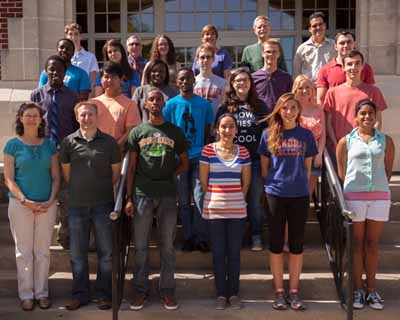 Have you ever wondered…
Have you ever wondered…
How particles affect climate?
How alcohol is toxic to the liver?
How laser light affects molecules?
How natural products are synthesized?
How green experiments are developed?
These and many other perplexing questions are being investigated every day at Hendrix College.
Explore below the diverse research projects being conducted in the Chemistry Department or
have a look at the research being conducted by our graduates.
Undergraduate Research Opportunities
The Caro Research Group is interested in the biochemical mechanisms by which alcoholic beverages produce liver damage. We use cell fractions (endoplasmic reticulum, mitochondria), cells (liver cells in culture), and experimental animals
(mice), and analytical, biological, and cellular chemical techniques including HPLC, polarography, real time PCR, RT-PCR, ELISA, western blot, chemiluminescence, fluorimetry, spectrometry, flow cytometry, and fluorescence microscopy.
Dr. Bill Gunderson’s research is in the field of
bioinorganic chemistry. Research in the Gunderson group has two aims: 1)
determine the role of manganese in biomacromolecules, including enzymes and DNA
structures, and 2) develop low-cost instrumentation for biochemical
and biophysical studies. The first aim includes investigations of the enzyme,
toxoflavin lyase, a Mn-containing enzyme that helps protect rice crops from
bacterial infections. These enzymatic studies include enzyme kinetics and
active site-structure studies using electron paramagnetic resonance (EPR)
spectroscopy and other spectroscopic methods. Dr. Gunderson is also
investigating the binding characteristics of Mn to DNA hairpins and three-way
DNA junctions using EPR spectroscopy. The second aim includes
developing spectroscopic techniques using 3D printing technology and Arduino
microcontrollers.
Our work targets the thermodynamic landscape associated with protein conformational stability. We obtain thermodynamic parameters such as Gibbs free energy, enthalpy, and entropy changes for thermal denaturation, through variable temperature nano-electrospray ionization ion trap mass spectrometry (vT-nESI-ITMS). We are also attempting to determine the thermodynamic aspects of denaturation through dielectric means, by varying the overall polarity of the solvent mixture. This work is a continuing collaboration with scientists at Indiana University.
The Hatch Research Group uses an integrative and multidisciplinary approach to study the effects of natural aerosols on the Earth system. We aim to better understand how natural aerosol influences atmospheric chemistry
and climate. Currently, we are working on two ongoing research projects. The first project combines theoretical and experimental results to predict the cloud condensation nuclei (CCN) activity of natural insoluble aerosols from water adsorption measurements on mineral dusts and volcanic ash using Fourier Transform Infrared (FT-IR) spectroscopy. The second project aims to explore the chemical composition of atmospheric aerosols using a high-volume aerosol sampler for collection of particles, followed by chemical characterization using ion chromatography (IC) and gas chromatography/mass spectrometry (GC/MS)
In the Kett Research
Group we are interested in studying surface and interfacial phenomena.
Specifically we look at how solid surfaces interact with adsorbed molecules and
how the adsorption process can be controlled through changes in ionic strength,
pH, and surface charge. Currently the group is focused on developing a kinetic
model for the formation of supported lipid bilayers (SLBs) on a silicon dioxide
(SiO2) surface. SLBs are a class of model biological membrane in
which a phospholipid bilayer is supported on a metal or non-metal surface. They
are used as mimics of biological cell membranes as the large number of
different molecules that are in a cell membrane makes it difficult to determine
the structure, dynamics and interactions of each individual membrane component.
Although SLBs can be formed on a number of different surfaces, they do not form
on all surfaces and it is not usually possible to make an a priori
prediction as to whether a particular combination of phospholipid
concentration, surface, salt concentration, temperature, and solution pH will
result in the formation of an SLB. By monitoring the real time formation of
SLBs using a Quartz Crystal Microbalance (QCM) we are developing a mechanistic
model that will allow us to determine how each of these experimental conditions
affects the formation of SLBs.